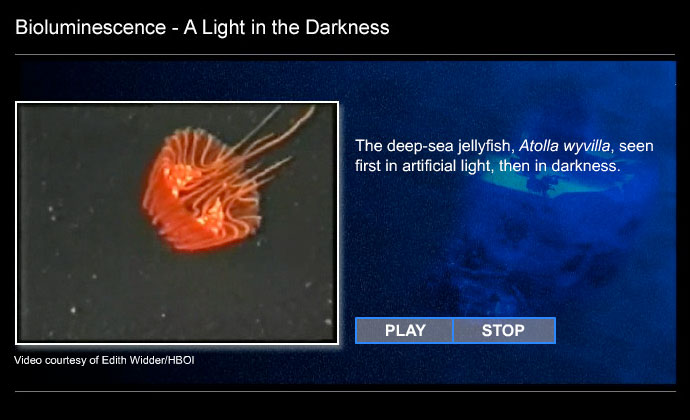Bioluminescence - A Light in the Darkness
Bioluminescence is light produced by an organism using a chemical reaction. While only a few land dwellers, like fireflies and some fungi, can make their own light, bioluminescence is very common in the deep sea. Bacteria, jellyfish, starfish, clams, worms, crustaceans, squid, fish, and sharks are just some of the groups of marine animals that have bioluminescent members.
All bioluminescent organisms use a reaction between an enzyme and a substrate to make light, but different species use different chemicals in the process. This suggests that the ability to make light evolved many times throughout the ages. Clearly, bioluminescence provides a survival advantage in the darkness of the deep-sea.
The videos below show two spectacular examples of bioluminescence in action. As you watch these creatures, try to imagine the purpose of their bold displays. Although scientists are beginning to understand the mechanics of bioluminescent activity, much of the purpose of these living lights is still unclear.
Study the images and light chart below, then answer the questions that follow each. They will help you understand how bioluminescence is used by deep-sea animals.
Questions
- Describe the pattern of bioluminescence shown by Atolla wyvilla.
[Check Answer]
The lights were very bright, and traveled around the animal flashing on and off.
- Jellyfish don't have eyes - why do you think they make light? (hint: scientists call this type of showy display a "burglar alarm")
[Check Answer]
The jellyfish's light show is a real attention-getter. If it lights up like that when grabbed or threatened by a predator, the visual commotion could either scare the predator away, or attract a bigger animal that might eat the predator before it ate the jellyfish.
- The blackdragon fish also has a burglar alarm bioluminescence display. But it makes light for other reasons, too. Describe the bioluminescence around its eyes. What do you think those lights are for?
[Check Answer]
The lights near the eyes are brighter, and cast a glow in front of the fish. These could act as little flashlights and help the fish find food.
- How does the bioluminescence of the fish change over the video? What does that change suggest about the mechanics of light production?
[Check Answer]
When the fish starts to bioluminesce, its lights are very bright and turn on and off rapidly. As time goes by, the flashing seems to slow down, and the lights get dimmer and dimmer and even start to go out altogether. Since the light is produced by a chemical reaction, the chemicals probably start to run out. Eventually the light "burns out" and the fish can't bioluminesce until its supply of chemicals is replenished.
- Bioluminescent light comes in many colors. But blue dominates in marine organisms. (Notice that the lights produced by the jellyfish and blackdragon fish were both blue.) Why?
[Check Answer]
According to the light penetration chart, blue light travels farther in water than all the other colors. If the purpose of bioluminescence is to set off an alarm or look for food, the light that will be visible at the greatest distance would be most desirable, and that is blue light.
- Because of the dominance of blue light, many of the creatures living in the deep ocean have eyes so adapted to pick up even faint or distant blue light that they can't see any other colors. So why do you suppose that a few fish species can both produce and see red light?
[Check Answer]
Fish that give off and see red light won't be able to see very far at all since red light is quickly absorbed in water. But in that small area, those fish can shine a light that no other animals can detect. As long as its prey is nearby, the red-lighting fish can find it, and its victims won't be able to see it coming.
Related Links
Multimedia Discovery Missions: Lesson 6 - Deep-Sea Benthos


